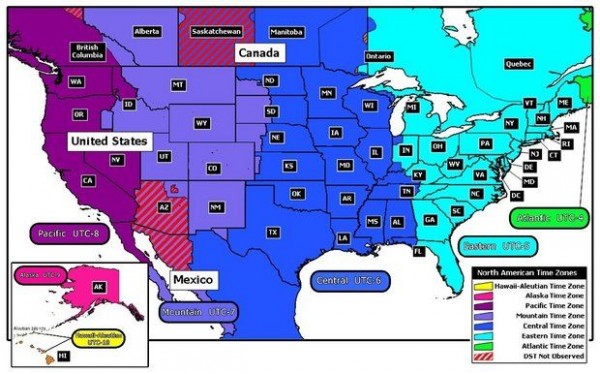Daylight Saving Time Begins This Weekend In Most Of U.S., Canada and Cuba
| Dan Weisman | | Oct 27, 2014 11:01 PM EDT |
(Photo : U. S. National Institute of Standards and Technology) This U.S. National Institute of Standards and Technology map shows the time zones in the United States and Canada.
Most of the United States will be setting clocks back an hour this weekend as Sunday marks the end of Daylight Saving Time. Only Arizona, Hawaii and parts of Indiana don't observe the bi-annual time change.
The change takes effect 2 a.m. Sunday, and won't go back to Daylight Savings Time until Sunday, March 8, 2015.
Like Us on Facebook
Worldwide, nearly 80 nations observe some form of daylight saving time while 160 don't. Besides the U.S., only Canada and Cuba and some Caribbean nations change clocks this year on Nov. 2, while other nations do it the last weekend in October.
Daylight Saving Time actually has become somewhat controversial over time. It was instituted during World War I in response to a German measure that was claimed to save fuel. Daylight Saving Time ended after the war.
The time change was brought back in World War II for a similar reason and basically never changed. While touted as a way to save energy, especially during the late 1970s energy crisis, the major reason given for the change was so rural children wouldn't have to withstand early morning darkness on the way to school.
The latest change in Daylight Saving Time took place when Congress passed the Energy Policy Act of 2005 decreeing time changes would begin during March's second Sunday and end on November's first Sunday beginning in 2007. Previously, it had taken place during the first Sunday in April and ended on the final Sunday n October.
Although the change of an hour may seem like a small deal, it actually makes a lot of difference in people's lives, according to studies published in the authoritative New England Journal of Medicine. Those show the number of heart attacks increase 25 percent during the first three days after the March change.
Energy saving aspects of the time change long have been disputed as practically negligible. The Department of Energy in 2008 said it actually cost the U.S. enough power to provide a year's worth electricity for 100,000 households.
©2015 Chinatopix All rights reserved. Do not reproduce without permission
EDITOR'S PICKS
-

Did the Trump administration just announce plans for a trade war with ‘hostile’ China and Russia?
-

US Senate passes Taiwan travel bill slammed by China
-

As Yan Sihong’s family grieves, here are other Chinese students who went missing abroad. Some have never been found
-

Beijing blasts Western critics who ‘smear China’ with the term sharp power
-

China Envoy Seeks to Defuse Tensions With U.S. as a Trade War Brews
-

Singapore's Deputy PM Provides Bitcoin Vote of Confidence Amid China's Blanket Bans
-

China warns investors over risks in overseas virtual currency trading
-

Chinese government most trustworthy: survey
-

Kashima Antlers On Course For Back-To-Back Titles
MOST POPULAR
LATEST NEWS
Zhou Yongkang: China's Former Security Chief Sentenced to Life in Prison

China's former Chief of the Ministry of Public Security, Zhou Yongkang, has been given a life sentence after he was found guilty of abusing his office, bribery and deliberately ... Full Article
TRENDING STORY

China Pork Prices Expected to Stabilize As The Supplies Recover

Elephone P9000 Smartphone is now on Sale on Amazon India

There's a Big Chance Cliffhangers Won't Still Be Resolved When Grey's Anatomy Season 13 Returns

Supreme Court Ruled on Samsung vs Apple Dispute for Patent Infringement

Microsoft Surface Pro 5 Rumors and Release Date: What is the Latest?










